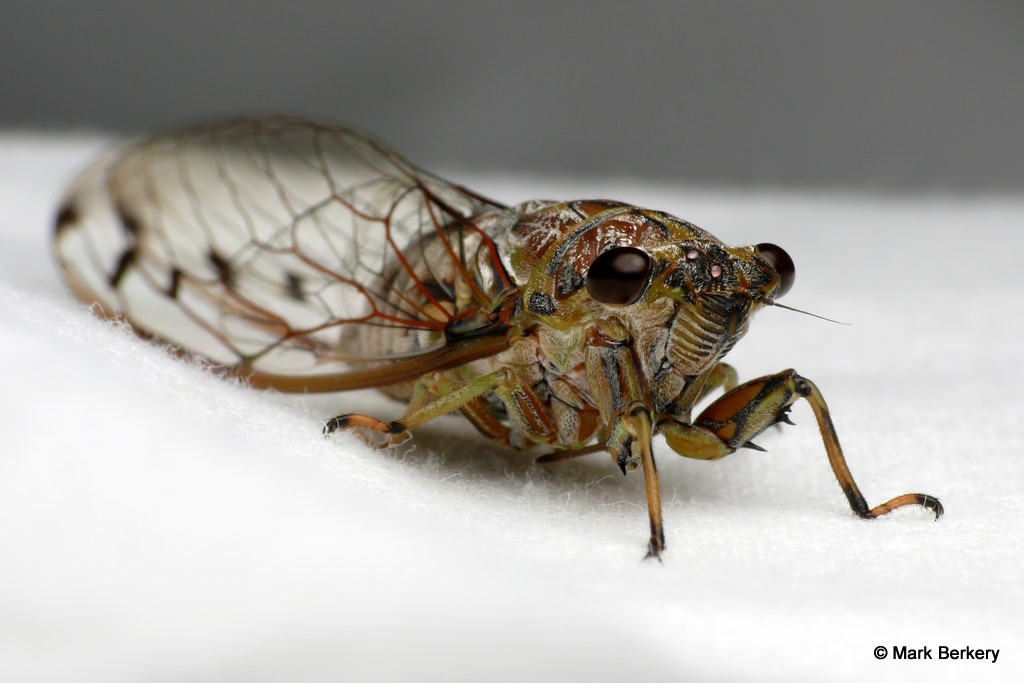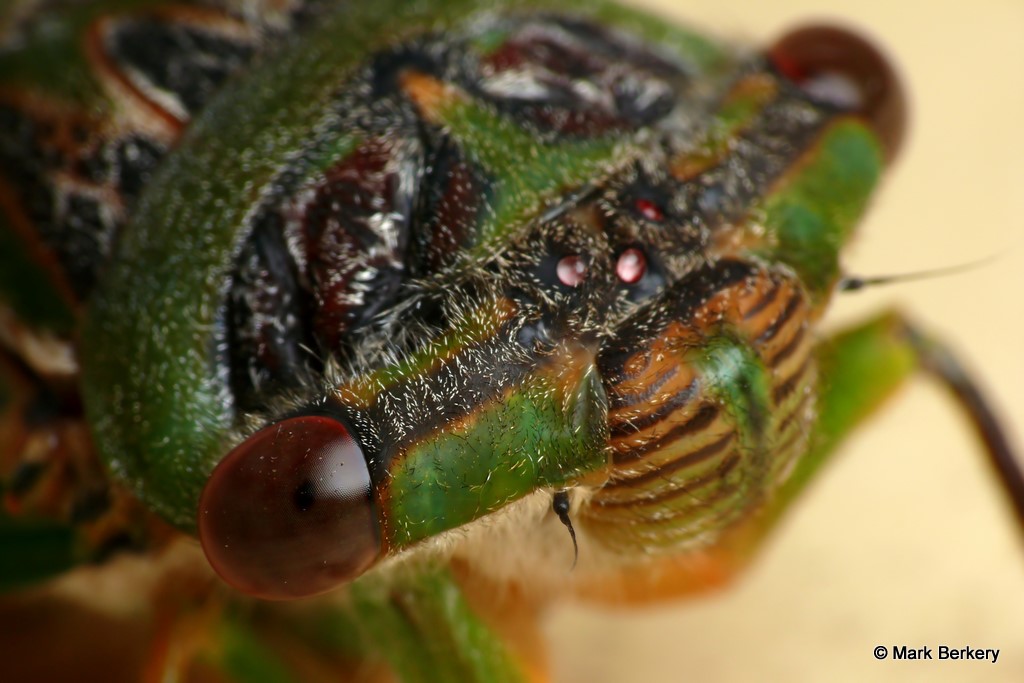


Moderators: rjlittlefield, ChrisR, Chris S., Pau



Sadly, this is one important limitation of integrated lenses on small sensor cameras. In their enthusiasm to protect photographers from diffraction blurring, the manufacturers don't provide diaphragms that stop down very far. This is OK for most purposes, but it becomes a problem when you add closeup lenses that increase the magnification without also increasing the effective f-number. With some extreme bodging, one could stop down outside the integrated lens, but who knows what this would do to the optical quality.No smaller stop available
They could be different species, they are different sizes and they looked to be different ages. I believe there are 200+ species in Aus, probably a good number around where I am.rjlittlefield wrote:Excellent pictures, as always.
I am intrigued by the different types of striping on these critter's faces. The first two appear to have light stripes formed mainly by hair, similar to the one I looked at HERE. The third one appears to have dark stripes in those same positions, with very little hair in sight. Are these different species, or just different individuals?
No smaller stop available
From what I (vaguely) understand the sensor size has limitations that come into play before aperture considerations, i.e. noise.Sadly, this is one important limitation of integrated lenses on small sensor cameras. In their enthusiasm to protect photographers from diffraction blurring, the manufacturers don't provide diaphragms that stop down very far. This is OK for most purposes, but it becomes a problem when you add closeup lenses that increase the magnification without also increasing the effective f-number. With some extreme bodging, one could stop down outside the integrated lens, but who knows what this would do to the optical quality.
Nothing against cropping but prefer not to for resolution. I want to be able to print what I post but that doesn't always work out.There is always the approach of back-off-and-crop, of course. Same diameter aperture at greater distance gives narrower entrance cone, more DOF, and all that.
--Rik
Sorry, but that's not correct. If noise were the issue, it would be the issue at all apertures and all magnifications. As your other pictures clearly illustrate, your sensor can capture enough light to produce pictures with excellent gradation and detail.MarkB1 wrote:From what I (vaguely) understand the sensor size has limitations that come into play before aperture considerations, i.e. noise.
Hi Bruce. The first two are about 1.5 inch long, the third is about 2 inch long and maybe 3/4 inch wide - eye to eye.Bruce Williams wrote:Really nice work. The first two pics have a real feeing of three dimensionality and weight to them - I really like them! It looks like quite a large insect (pics 1 and 2) - so what size are we looking at here Mark?
Bruce
Hi Rik. Looking at that now I don't know what I was thinking. I (literally) knocked my head on a steel girder holding up a low ceiling yesterday, twice. Woke with a terrible headache and stayed in bed today.rjlittlefield wrote:Sorry, but that's not correct.MarkB1 wrote:From what I (vaguely) understand the sensor size has limitations that come into play before aperture considerations, i.e. noise.
--Rik
I think the issue is more what customers want, or more precisely, what they'll be happy with.MarkB1 wrote:Maybe the only issue would be actual aperture size would have to stop somewhere before it became too small to let light in effectively?
Rik, You have to be kidding! Landscapes, which I assume to be included in "scenics", are the domain of true obsesssion with everything being sharp from foreground to the horizon, with small apertures , traditionally, being de rigeur.rjlittlefield wrote:Most people shoot things like scenics and portraits. In that regime, sharpness is a big issue, DOF is not, and providing very small apertures would be counterproductive because the resulting pictures would be obviously unsharp.
No, but as sometimes happens I oversimplified to focus on the situation at hand. It would have been more accurate to say that people have a stricter criterion for sharpness in scenics than they do in bug faces.Harold Gough wrote:Rik, You have to be kidding!rjlittlefield wrote:Most people shoot things like scenics and portraits. In that regime, sharpness is a big issue, DOF is not, and providing very small apertures would be counterproductive because the resulting pictures would be obviously unsharp.
It's important to remember that the effect of f-number scales along with the sensor size. With regard to DOF and diffraction blur, f/11 on Mark's FZ50 is equivalent to about f/390 on an 8x10 view camera. I'm under the impression that such small apertures are very seldom used in landscape photography, and that using tilts and a larger aperture would be the traditional solution. To put this in perspective, the famous "f/64 club" was named after an aperture that would be in the range of f/1.8 to f/3.6 on Mark's camera.Landscapes, which I assume to be included in "scenics", are the domain of true obsesssion with everything being sharp from foreground to the horizon, with small apertures , traditionally, being de rigeur.
Agreed. The point I was trying to make was only that while smaller apertures would sometimes be useful for bug faces, neither scenics nor portraits of people will push the manufacturers to go smaller than they already provide.Portraits are at the other end of the scale, shallow DOF and softness being desirable, the latter where children and women are models.
What Brian is saying here is what I've always thought to be the the case and what I was trying to say in another thread (scroll down here: http://www.photomacrography.net/forum/v ... php?t=8641).LordV wrote:Just to put a slightly different slant on DOF/Diffraction issues on small sensor cameras, I suspect our view that you seem to get better DOF without the diffraction is caused simply by the use of small focal length lenses on these cameras which give much greater apparent DOF than longer lenses. Apparent DOF being the area that is actually OOF but still very recognisable. The exact opposite of the effect of longer lenses with creamy bokeh which appear to have much thinner DOF but in reality lack much apparent DOF.
Brian v.
So, right now I'm not sure what to believe in this issue. Best thing would of course be to follow Rik's suggestion and do some tests!rjlittlefield wrote:This issue is difficult to analyze and difficult to talk about. In macro setups, with the same magnification and the same effective f-number, the region of small blurs is so close to identical for all focal lengths that I doubt you would see any difference there. However, when the blurs get much bigger than the circle of confusion, as in the far background, then things get more complicated and there can be visible differences.
*snip*